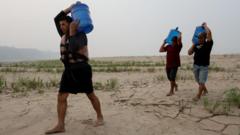Are Recent Droughts a Slow-Moving Global Catastrophe? Insights from the UN Report

The Silent Killer: Understanding the Global Drought Crisis
In recent years, drought has emerged as a pressing global issue, impacting various regions across the world, from Somalia to mainland Europe. The alarming trend has been exacerbated by climate change, leading to what experts describe as one of the most devastating droughts in recorded history. According to a UN-backed report, drought is a "silent killer" that "creeps in, drains resources, and devastates lives in slow motion." This article aims to explore the multifaceted ramifications of drought, its link to climate change, and the urgent need for proactive measures to mitigate its effects.
Understanding Drought: What It Is and How It Affects Us
Drought refers to an extended period of deficient rainfall relative to the statistical multi-year average for a region. It can significantly affect agriculture, water supply, and ecosystems, leading to food insecurity, economic instability, and social unrest. The report highlights how drought has particularly affected vulnerable populations, compounding issues like poverty and ecosystem collapse.
Global Impact of Drought: Regions at Risk
The UN-backed report outlines several regions that are most affected by drought, including:
- Africa
- The Mediterranean
- Latin America
- Southeast Asia
In Somalia, for instance, approximately 4.4 million people are facing crisis-level food insecurity as of early 2023. The situation is dire, with previous droughts leading to the deaths of an estimated 43,000 people in 2022 due to drought-linked hunger.
The Role of Climate Change and Natural Phenomena
The connection between climate change and drought is increasingly evident. Rising global temperatures lead to altered weather patterns, which can intensify drought conditions. The report emphasizes that the warming effects of climate change have been exacerbated by the El Niño phenomenon, which is characterized by unusually warm surface waters in the eastern and central tropical Pacific Ocean. This natural climate event often results in drier conditions in various regions, including:
- Southern Africa
- Parts of Southeast Asia
- Northern South America
- Southeastern Australia
Drought's Devastating Effects on Wildlife and Ecosystems
The impact of drought extends beyond human populations and significantly affects wildlife and ecosystems. In Botswana, for instance, hippos have been stranded in dry riverbeds, while in Zimbabwe and Namibia, elephants have been culled to feed starving communities. Drought disrupts the delicate balance of ecosystems, leading to habitat loss and increased vulnerability of endangered species.
Socioeconomic Implications of Drought
Drought is not merely a natural phenomenon; it is a social and economic emergency that has far-reaching consequences. The report highlights how women and children are disproportionately affected by drought, often leading to desperate measures. For instance, forced child marriages have more than doubled in regions of Eastern Africa severely impacted by drought, as families seek dowries to survive. These measures have long-term implications for gender equality and the well-being of future generations.
Preparing for the New Normal: Recommendations from Experts
The report underscores the necessity for governments and communities to prepare for a "new normal" in the face of ongoing and future droughts. Here are some recommended measures:
- Implementing stronger early warning systems to predict and prepare for drought conditions.
- Enhancing water management practices, including sustainable irrigation techniques.
- Investing in climate-resilient infrastructure to mitigate the effects of drought on agriculture and water supply.
- Fostering community awareness and education programs about drought preparedness.
The Economic Ripple Effect of Drought
Drought does not only affect local communities but has global economic implications as well. For instance, between October 2023 and January 2024, drought conditions resulted in significantly lower water levels in the Panama Canal, leading to a reduction in daily ship transits from 38 to 24. Such disruptions can affect global trade and supply chains, heightening the urgency for better management and preparedness.
The Path Forward: Addressing the Drought Crisis
As Dr. Kelly Helm Smith, a co-author of the report, aptly points out, "Drought is not just a weather event." It is a complex social, economic, and environmental challenge that requires comprehensive strategies. The essential question is not whether droughts will occur again but whether societies will be better prepared for their inevitable return.
Conclusion: A Call to Action
The ongoing drought crisis serves as a wake-up call for governments, organizations, and individuals alike. By understanding the multifaceted nature of drought and its impacts, we can take collective action to build resilience and safeguard vulnerable populations. Whether through improved monitoring systems, sustainable agricultural practices, or community engagement, the time to act is now. We must prepare for the future to mitigate the consequences of this silent killer.
Frequently Asked Questions (FAQs)
What are the primary causes of drought?
Drought is primarily caused by prolonged periods of low precipitation, exacerbated by climate change, which leads to increased temperatures and altered weather patterns. Human activities such as over-extraction of water resources also contribute to the severity of drought conditions.
How does drought affect food security?
Drought leads to reduced crop yields and livestock productivity, resulting in food shortages and increased prices. Vulnerable populations may experience crisis-level food insecurity, as seen in regions like Somalia, where millions face the threat of hunger.
What steps can individuals take to prepare for drought?
Individuals can prepare for drought by conserving water, practicing sustainable gardening, and staying informed about local water conservation efforts. Community engagement and advocacy for better water management policies are also crucial.
Are there any technologies that can help mitigate drought effects?
Yes, technologies such as satellite monitoring systems for weather patterns, advanced irrigation techniques, and water recycling systems can significantly help in managing water resources more effectively and reducing the impact of drought.
As we confront the realities of climate change and its implications on drought, it is imperative to take action. What measures do you think are most effective in combating the drought crisis? #DroughtAwareness #ClimateChange #SustainableFuture
Published: 2025-07-02 12:35:07 | Category: technology



